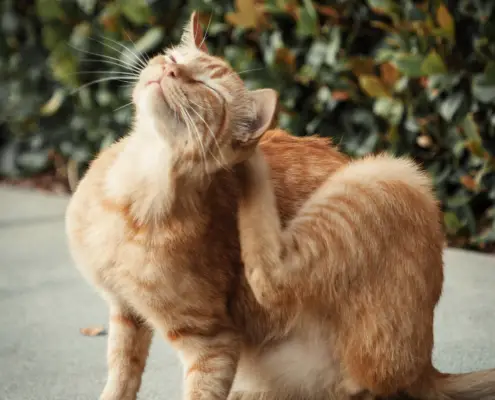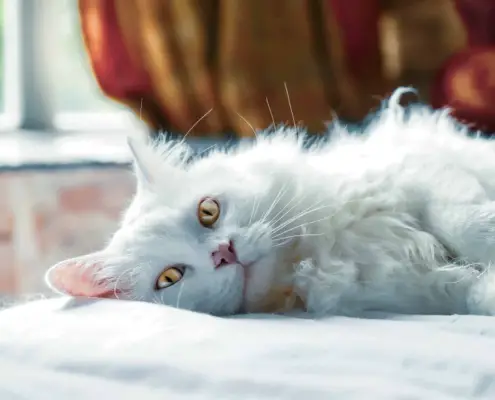
Feline reproduction is a fascinating and complex topic that many cat owners may not fully understand. Cats, like humans and other mammals, have reproductive cycles that govern their ability to reproduce and have offspring. Understanding the intricacies of feline reproduction is crucial for cat owners to provide appropriate care for their pets.
Understanding the reproductive cycle in female cats
The reproductive cycle in female cats, also known as the estrous cycle, is quite different from the menstrual cycle in humans. Unlike humans, who have a monthly reproductive cycle, female cats are polyestrous, which means they can go through multiple reproductive cycles throughout the year. These cycles are influenced by various factors, including the length of daylight and the presence of male cats.
The feline reproductive cycle consists of several distinct stages. The first stage is called proestrus, during which the female cat may exhibit behavioral changes, such as increased vocalization and restlessness. This stage lasts for a few days and is followed by estrus, also known as the “heat” period. During estrus, female cats become receptive to mating and may display behaviors like rolling on the floor and rubbing against objects.
Key differences between feline and human reproductive systems
While both feline and human reproductive systems serve the purpose of reproduction, there are significant differences between the two. One of the key differences is that female cats do not menstruate like humans. Menstruation in humans is characterized by the shedding of the uterine lining, which results in bleeding. In contrast, female cats reabsorb the uterine lining if they do not conceive during their reproductive cycle.
Additionally, female cats do not have a monthly reproductive cycle like humans. Cats are induced ovulators, which means that they ovulate in response to mating. This is why female cats can go into heat multiple times throughout the year, depending on various factors. In contrast, human females have a fixed monthly cycle, which is regulated by hormonal changes.
Do female cats have periods?
Contrary to popular belief, female cats do not have periods in the same way that human females do. As mentioned earlier, cats do not shed the uterine lining and experience bleeding if they do not conceive during their reproductive cycle. Instead, the uterine lining is reabsorbed by the body.
However, it is important to note that female cats do exhibit certain behaviors and physical changes during their reproductive cycles that may resemble human menstruation. For example, they may become more vocal, restless, and affectionate. Some cats may also exhibit increased urination and interest in male cats. These signs are indicative of the cat being in heat, not experiencing a menstrual period.
Signs and symptoms of feline reproductive cycles
It is essential for cat owners to be familiar with the signs and symptoms of feline reproductive cycles to provide appropriate care for their pets. During the proestrus stage, female cats may exhibit mild behavioral changes, such as increased vocalization and restlessness. As they enter the estrus stage, they become more receptive to mating and may display more pronounced behaviors like rolling on the floor and rubbing against objects.
Physical signs of feline reproductive cycles can also include swollen genitals, increased urination, and a strong, distinct odor. It is important to note that these signs can vary among individual cats, and not all cats will exhibit the same symptoms. Some cats may show subtle changes, while others may have more pronounced signs of being in heat.
Spaying and neutering: The impact on feline reproductive cycles
Spaying and neutering are common procedures performed on cats to prevent unwanted pregnancies and provide various health benefits. Spaying involves the removal of the uterus and ovaries in female cats, while neutering involves the removal of the testicles in male cats. These procedures have a significant impact on the reproductive cycles of cats.
In female cats, spaying eliminates the reproductive cycle entirely. Without the ovaries and uterus, female cats no longer go into heat or exhibit the signs and symptoms associated with reproductive cycles. This can help prevent unwanted behaviors, such as yowling and spraying, and reduce the risk of certain reproductive-related health issues, such as uterine infections and certain types of cancers.
Common misconceptions about feline reproductive cycles
There are several misconceptions surrounding feline reproductive cycles that can lead to misunderstandings and misinformation. One common misconception is that female cats need to have a litter of kittens before being spayed. This is not true. Cats do not have a psychological need to reproduce, and spaying them at an appropriate age is beneficial for their overall health and well-being.
Another misconception is that allowing a female cat to go through a heat cycle is necessary for her health. In reality, the opposite is true. Allowing a cat to go into heat repeatedly without breeding increases the risk of certain health problems, such as pyometra, a potentially life-threatening infection of the uterus. Spaying is the best way to prevent these health issues and ensure a long and healthy life for your cat.
Managing feline reproductive cycles: Tips for cat owners
While spaying is the most effective way to manage feline reproductive cycles, there are some tips that cat owners can follow if they choose not to spay their cats. One option is to keep the cat indoors during the time she is in heat to prevent unwanted pregnancies. This can be done by providing a safe and stimulating indoor environment to keep the cat occupied and reduce her desire to go outside.
Providing environmental enrichment, such as interactive toys and scratching posts, can also help distract a cat in heat and alleviate some of the behavioral changes associated with the reproductive cycle. Additionally, keeping male and female cats separated during the female’s heat cycle can help prevent unplanned mating.
When to consult a veterinarian about feline reproductive health
It is important to consult a veterinarian about feline reproductive health if you have any concerns or questions. A veterinarian can provide guidance on the best course of action for managing your cat’s reproductive cycles and discuss the benefits of spaying or neutering. They can also address any health issues that may arise, such as infections or reproductive cancers.
Regular veterinary check-ups are essential for maintaining the overall health and well-being of your cat. During these visits, the veterinarian can assess your cat’s reproductive health and provide any necessary treatments or recommendations. By working closely with your veterinarian, you can ensure that your cat receives the best possible care for her reproductive health.
Understanding and caring for your cat’s reproductive health
In conclusion, female cats do not have periods in the same way that humans do. While they do go through reproductive cycles, they do not shed the uterine lining and experience bleeding if they do not conceive. Understanding the differences between feline and human reproductive systems is crucial for providing appropriate care for your cat.
Spaying and neutering are effective ways to manage feline reproductive cycles and provide various health benefits. It is important to consult a veterinarian about your cat’s reproductive health to ensure the best possible care. By staying informed and proactive, you can help your cat live a happy and healthy life.
If you enjoyed my article, I would appreciate you sharing it with your network.

Sima Ndlebe
Sima writes for CatBuzz. He is interested in Cats, Health and Fitness, and Entrepreneurship.
Published: 5 June 2024
Related Articles
Disclaimer
The content found on CatBuzz.org is presented on an "as is" basis and is intended for general consumer information and education purposes only. Any utilization of this information is voluntary and solely at the user's own risk.
None of the articles or content should be regarded as, or used in place of, veterinary medical advice, diagnosis, or treatment. The information provided on the website is purely for educational and informational intentions and should not be considered a substitute for professional guidance from a veterinarian or other qualified expert. The articles are designed to inform consumers about veterinary healthcare and medical matters that may impact their cat's daily life. It should be noted that this website and its services do not constitute the practice of any form of veterinary medical advice, diagnosis, or treatment. CatBuzz.org explicitly disclaims any liability for any direct or indirect damages or losses that may arise from the use of or reliance on the information contained within the content.
Consumers must consult a veterinarian, veterinary specialist, or another qualified veterinary healthcare provider when seeking advice regarding their cat's health or medical conditions. It is important not to ignore, avoid, or postpone seeking medical advice from a veterinarian or other qualified veterinary healthcare provider solely based on information obtained from this website. If you believe that your cat may be experiencing a medical issue or condition, it is imperative to promptly contact a qualified veterinary healthcare professional.



